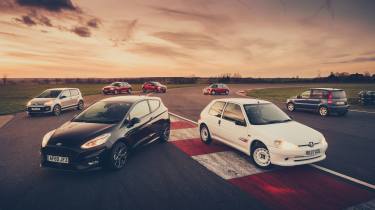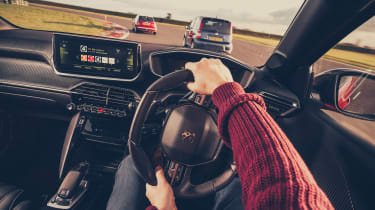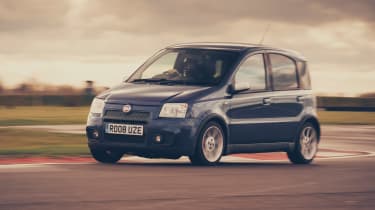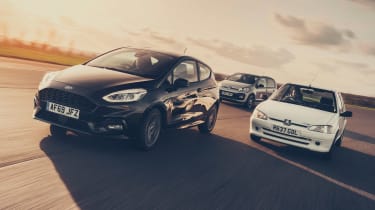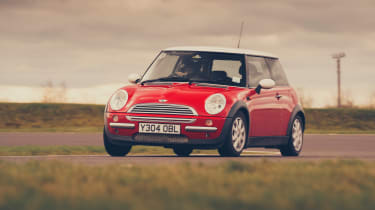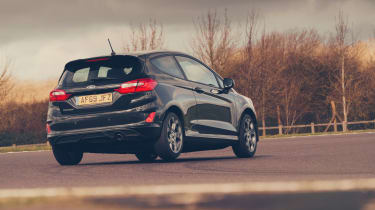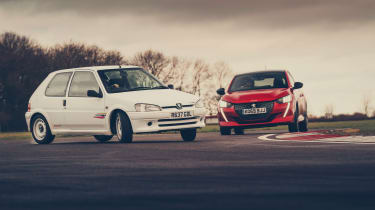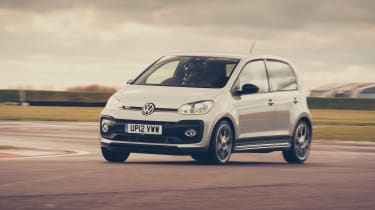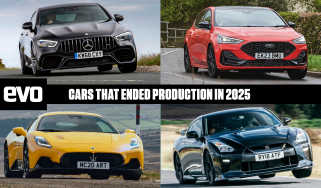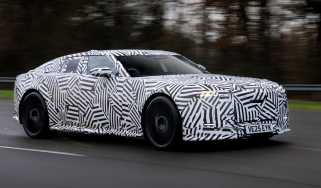Old vs new supermini test – 100bhp heroes go head-to-head
Are superminis still fun? Four new players meet three evo favourites from the not-too-distant past to discover if new can beat old for driver appeal
Seven hundred and forty-nine bhp could be the power output of a new McLaren, and it’s about what you’d expect of a pair of all-wheel-drive superhatches, while 24 cylinders is neat shorthand for our super-estate test, or perhaps our Superfast v Superleggera comparison of evo 264.
Now though, those figures are divisible between not two or three cars, but among seven. Assembled is a group with an average weight of under 1050kg, the lightest among them significantly undercutting a Lotus Elise Sport 220. All bar one of the seven has a manual gearbox, and three of those give you only five ratios to choose from.
> Ford Fiesta ST review – super supermini still appeals, especially in Edition trim
It’s been a while since evo examined the state of play down at the dinky end of the spectrum. One reason, truth be told, is that we weren’t sure whether we’d like what we found. It won’t have escaped your notice that modern hatchbacks are quite different from their counterparts of a decade or two ago. Bigger, more technologically advanced, and a whole lot safer for sure, but also heavier and less effervescent.
They’re expensive, too. The steepest of today’s collection, the Peugeot 208 GT Line, comes in at a frankly incredible £25,555 including options. Even adjusted for inflation, that makes it more than £6000 dearer than the oldest of our septet, my own Peugeot 106 Rallye, which cost £9895 in 1998, equivalent to little more than £18,000 today.
There’s a good reason to explore what’s available at this end of the market though, and not just because the prices of bigger, more potent machines in The Knowledge are starting to look like telephone numbers. A fresh crop of hatches has arrived in the last few months, making now the perfect time to separate the wheat from the chaff.
Newest of all is the aforementioned Peugeot 208, and its PSA cousin the Vauxhall Corsa, here in SRi Nav Premium trim. Volkswagen’s Up GTI has just returned after a brief WLTP-enforced hiatus, and while it’s not technically in the same size class as the other newcomers and sports a heftier price tag than before, it’s our current favourite in the sub-£20k bracket. And for good measure, we’ve thrown in a Fiesta. Britain’s favourite car has long been a class leader for driving fun, even outside of the obvious ST models – and the ST-Line we have here is just a notch or two down from the hot version in Ford’s range.
A moment to address those missing. There’s no new Clio, as Renault deemed it ‘not quite the right car for this test’ (make of that what you will). Suzuki’s flyweight Swift in EcoBoost-rivalling 1-litre BoosterJet form is no longer on sale (and we decided the Sport was a little too potent to fit into this group), while Mini was also unable to supply the charming entry-level One Classic we were after. Experience of the VW Group trio (Polo, Ibiza and Fabia) suggests they’re big on quality but short on fun factor, and the less said about the hybrid Jazz or Yaris the better.
One thing linking all contenders is what you could long-windedly describe as the ‘hundred horsepower or so’ bracket. Our four modern cars come equipped with compact three-cylinder turbocharged engines, the Corsa making 99bhp, the 208 100bhp, the Up 113bhp and the Fiesta 123bhp. In years gone by, this loose classification has turned out some of evo’s favourite small cars, and for that reason we thought we’d also bring a few of those along, to see if any of the newcomers capture the same magic.
Oldest is the ‘Series 2’ Rallye, which made 103bhp as a brand-spanker and shed equipment and sound insulation material to make the most of its modest output. It’s hard to argue with Peugeot’s method – its 8.8sec 0-62mph time isn’t bad considering the two gearchanges needed to get there, and Peugeot Sport’s engineers put their best work into the chassis too, carrying over the more powerful and more expensive 106 GTi’s set-up.
It seems extraordinary, but our next contender left the showroom only a few years after my Peugeot. Jason Field’s 2001 R50 Mini Cooper is part of the Y Register – an owners’ club and resource dedicated to the very earliest of BMW’s Minis – and in reality the reborn Mini hit the market a whole decade after the 106’s 1991 debut.
It too features a 1.6-litre four-cylinder, but technological advancements and a 16-valve head allowed for a higher 114bhp output, making it the second-most powerful car here today after the Fiesta. It’s also on tall, skinny tyres and 15-inch wheels – allegedly the sweet spot for an R50.
Our final old stager is one undergoing something of a renaissance in the used car market, and it’s as intrinsically linked with evo as Porsche 911s, Subaru Imprezas and Lotus Elises. The Fiat Panda 100HP cost under £10,000 when new in 2006, and thrilled us with its chunky styling, revvy engine and rough and tumble handling.
Today’s example was recently purchased by James Brodie of our sister title Auto Express, and is no stranger to evo, being a former press car we enjoyed back in issue 132. It’s pretty representative of the sort you can now pick up for only a couple of grand – slightly more than early Coopers, and around half what S2 Rallyes currently start at. Each of the older trio is equivalent to the down payment on one of the newer machines, but today is about using the oldies as a yardstick for entertainment, rather than drawing pointless conclusions between the value of old versus new.
The whole bunch is going to have its work cut out to top the 106 for grins. On a greasy Bedford Autodrome the Peugeot is fast, tactile, completely absorbing, and utterly hilarious. It starts with the sheer size of the thing, or rather the lack of it. You don’t so much step into the Rallye as put it on, and once you’ve sunk into the squidgy, old-school French seat you’ve almost got better visibility than in a Caterham thanks to pillars like welding wire and glazing to rival the Crystal Palace.
Wiggle room in the steering, gearshift and pedals suggests the Pug’s age will count against it, but that’s just an illusion. On the move the throttle response is instinctive, the gearshift becomes tense and tactile. You need just the slightest of steering inputs to deflect the nose from the straight-ahead, while the balance is as throttle-adjustable as a rear-driver’s. It feels resilient too, like you could run it flat out all day with few ill effects.
The limits are easy to find: turn in with a lift, up pops the inside rear, and you’re pitched into an enormous tailslide that needs rapid steering work, plenty of throttle and the stifling of guffaws to gather up again. I manage to avoid a spin, but I almost fall out of the Fiesta laughing when a colleague fishtails the 106 wildly into the grass. But get it right, with each end brushing over the surface between grip and slip, and you’ll feel like Gilles Panizzi.
The Panda couldn’t be more different. Everything happens at the front axle rather than being divided between the two, and you’re acutely aware of it from your high perch behind a chunky steering wheel and that gearshift less than a hand-span away.
The 99bhp engine and six-speed gearbox are the finest and feistiest here. The Panda worries the 106 and Fiesta – subjectively the quickest cars – in a straight line, and the 1.4-litre twin-cam rasps like an old Alfa. The feel of the short-throw lever is addictive; you’d noodle around the ’box even if the autograss-style ratios, which have you almost in fourth by 60mph, didn’t loudly demand it.
I owned a 100HP around a decade ago, a purchase galvanised by reading the exploits of Dickie Meaden et al in evo – coincidentally, the same explanation given by Brodie for buying this car. I rarely ever used Sport mode, finding the increased throttle response low down a bit jumpy (above 3000rpm or so it’s no different), but today I’m regretting that as it feels spot-on. The extra steering weight in Sport is welcome too, and there’s genuine feedback, even if it’s mostly indicating understeer. On track the Panda washes wide very early indeed and even jabbing the brakes mid-corner fails to unlock the rear axle, but it’s more manageable on the road and tends to indicate its limits by spinning an unloaded inside wheel.
The narrow body makes it feel predictably wieldy, but what I didn’t expect is a sense of integrity that matches that of the new cars – at just over 41,000 miles, there’s not a single grumble from the trim. Nor could I foresee a secondary ride that’s borderline acceptable these days, which probably says more about stiffly sprung modern cars than anything else.
The Mini, surprisingly, feels flakier than the Panda. There are a few squeaks and rattles, wind whistles around the frameless door windows, and the shell creaks slightly over rough surfaces. Contemporary styling makes you forget that it’s nearly as old as the Rallye, but the years haven’t been as kind to it as they have the French or Italian offerings.
It feels old school in other ways too. Like with the 106, the pillars are slim and the glass expansive, more open and inviting than a modern Mini’s. The retro cabin’s shape is ageing well too, even if the fidgeting plastics disagree, and while the two-spoke steering wheel looks like a Teletubby, both its size and section feel good in the hands.
The hydraulic steering whines as you mooch around at parking speeds, but immediately squirms with feedback on the move. Throttle response is good and the gearshift slick, but the Mini’s relative modernity is betrayed by elongated gear ratios that sap pace from the otherwise rorty 1.6. The Cooper needs working hard to keep up with the torquier Fiesta for our photography, but the corners are where it comes alive.
Two decades on, the R50 Cooper still has the moves. The steering’s weight and response are just about perfect for a small hatch, and like with the 106, grip levels are evenly balanced from the moment you turn in. The front settles early and a little lift brings the rear into play, but in a friendlier way than with the Rallye with its Cutty Sark wheel twirling.
On the road the Mini breathes with the surface on its tall sidewalls, yet body control is tight. With the wheels pushed to each corner and a low-slung seating position, you seem to operate the Mini from its centres of roll, mass and gravity.
Of the modern quartet, the Fiesta feels closest to the Mini, aside from a driving position that’s more Foden than Ford and a windscreen somewhere in the next county. But if you can’t stretch to an ST, you could do far worse than to spend your more modest balance on the ST-Line.
You miss out on a sprinkling of visual glitz inside and out, and for all its willingness the 1-litre EcoBoost can’t match the thump of its 1.5-litre cousin, but in the twisties there’s really not a huge gulf between the mild and spicy Fiestas. In some ways, the ST-Line gets uncomfortably close – it’s less combative on poor surfaces, certainly, and particularly rough bits don’t have you wincing in anticipation.
And with a little more roll to soak up the steering’s quick responses, it doesn’t feel as hyperactive on turn-in as the hottest Fiesta. On track it’s not as lairy, without the ability to fully disengage its systems and get a real feel for the chassis, but that doesn’t really matter on the road, and all the usual Fiesta precision and feedback are still there in abundance.
It’s the car the new 208 and Corsa have to beat, at least dynamically. Both are probably ahead of the Fiesta for quality, desirability and everyday comfort. The Corsa is the more conventional of the pair, but offers greater on-paper performance thanks to its manual gearbox. To my eyes it’s not unattractive either, although Retirement Red is best avoided, and you don’t get a three-door option like you do with the Fiesta and Up.
The six-speed ’box shifts sweetly enough although doesn’t feel like part of the experience. One issue is the engine it’s paired to: it performs well, if not with the fizz of the older cars (or indeed the Up), and you can use every bit of that performance on the road. Unfortunate then that the three-pot has the power delivery of a joke with no punchline, with plenty of go at part-throttle but nothing extra when you pin it to the carpet.
Oddly, the 208, with its identical engine but automatic gearbox, is actually a better proposition. It still pulls harder at half-throttle than wide open, but shorter ratios in its eight-speed ’box give it more seat-of-the-pants pep despite it being slower on paper, and the changes (aided by paddles behind the wheel) are quicker than waiting for the Corsa’s revs to drop between every change.
Peugeot’s i-Cockpit with its new holographic Star Trek dials and low-set, small-diameter wheel will forever be anathema to some, but the quirky layout immediately puts me in mind of the chuckable Peugeot Sport 208. The small wheel makes the Pug feel nimble, and the whole car is more playful and pliant than the otherwise similar Vauxhall. The Corsa rides and handles neatly and doesn’t object to being taken by the scruff, but the Peugeot feels lighter on its feet and has a touch more feedback through its controls. The Rallye makes it feel like a 508, but there’s enough verve to suggest someone at PSA still remembers the days of 106s and 205s.
It has sharper styling than the Corsa or Fiesta too, and is undoubtedly a desirable product even if it’s more competent than it is truly fun. And the car that puts some perspective on this is the last of our modern gathering, the Up GTI, which is not just more desirable but gets closer than the other moderns here to the stripped-back enjoyment of the oldies.
The engine immediately feels more eager than those of the other new cars, despite losing out on ten horses to the Fiesta’s. You can almost certainly put that down to weight, as the 995kg GTI is 74kg lighter than the Ford. It’s 55kg less than the Mini, too. Low-end response is the strongest here, and while the snorty burble of the three-cylinder is digitally enhanced, the extra noise is more than welcome next to its meek-sounding peers.
Keep your toe down and the GTI scampers away from the other three-pots, and kicks dust in their faces by actually shedding revs when you go for the next gear, so you can snick through each ratio without a head-nodding jolt. The shift itself has the quality of an unexpectedly flimsy handshake, but it’s quick enough to knock around the gate, while sensibly spaced and weighted pedals make it easier to heel-and-toe than the Vauxhall or Ford.
Electronics call time on 106-style cornering silliness but there’s enough movement in the chassis to appreciate the Up’s agile character. You don’t get much conversation through the front wheels, but the measured responses and faithful front end give it the most natural and reassuring B-road pace in our group, and it doesn’t fight you over the chaotic asphalt patchwork left by our beloved energy and telecoms industries.
What all the newer cars share, to varying degrees, is that first-car joy of whipping along in something as fast as it, rather than as fast as you, can go. There’s a certain satisfaction in testing the car rather than your own physical and mental limits, and all four of the modern cars here are limited just enough by performance and adhesion that most people reading this could probably get the best from them. Other commentators have coined the idea that it’s more fun to drive a slow car fast than a fast car slow, and the 208, Corsa, Fiesta and Up all offer that sensation.
What they don’t do is spoon it out as liberally or potently as the Rallye, Cooper and 100HP. The past decade or two has given us small cars that would once have been considered luxury vehicles, but in doing so they’ve unavoidably moved away from the raw thrills offered by their predecessors.
Of those older cars, the Rallye is hard to beat, and I’m not saying that just because I own it. Others who drove it on the day were effusive about its tactility and fun factor, but equally, it’s hard to imagine how manufacturers could replicate that formula today. This arguably makes the Mini and Panda more impressive, as they both offer more contemporary levels of equipment and safety, but don’t sacrifice fun in doing so.
And if you want a true spiritual successor to the 106 Rallye, R50 Mini Cooper and Fiat Panda 100HP, then our recommendation would be to visit your local Ford or Volkswagen dealerships. The Fiesta isn’t just the nation’s favourite supermini, but also its best handling, while no current small car is more desirable or entertaining than the boxy little Up GTI.
This review was first published in evo 273. For the latest issue, or to subscribe, click here

